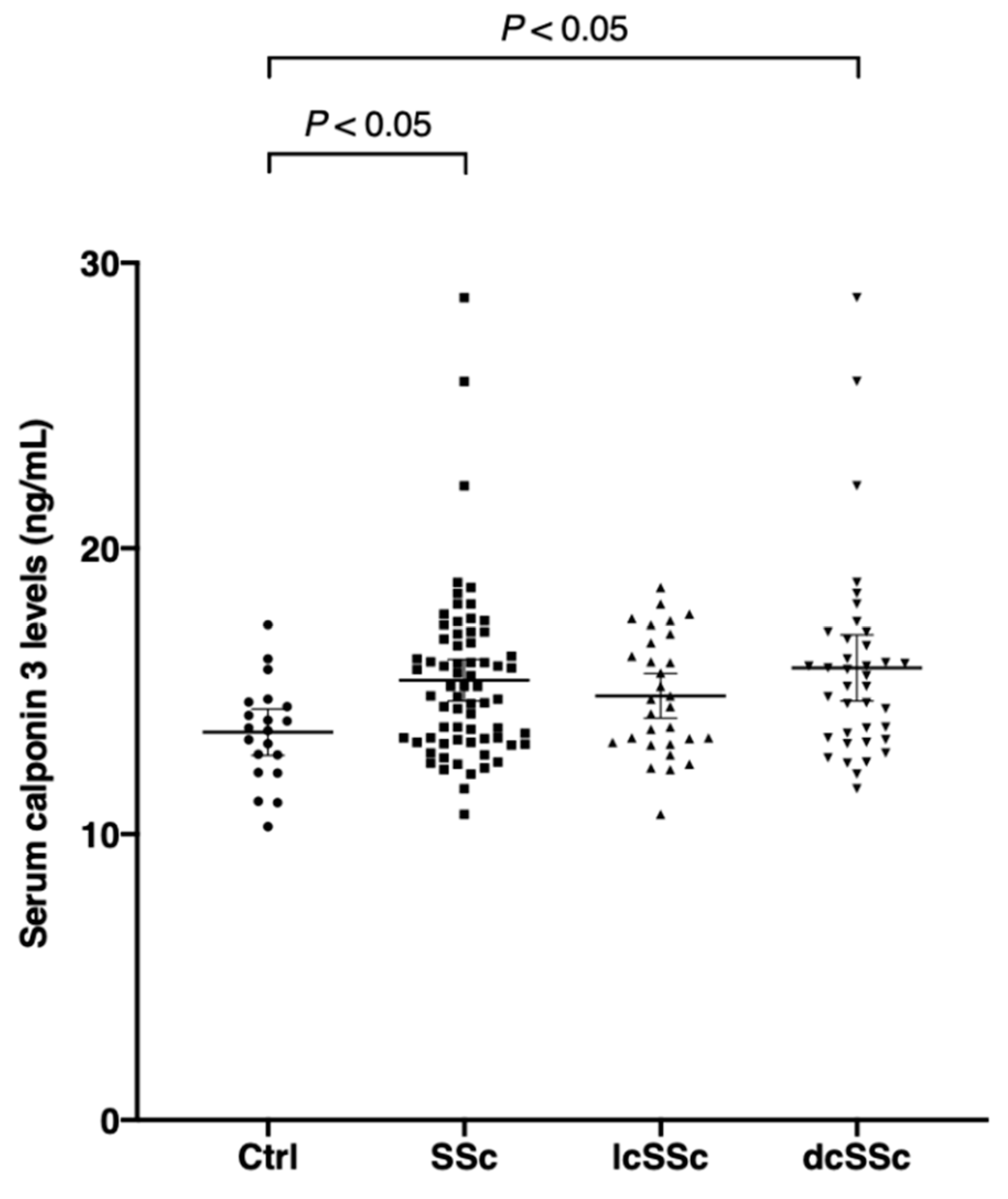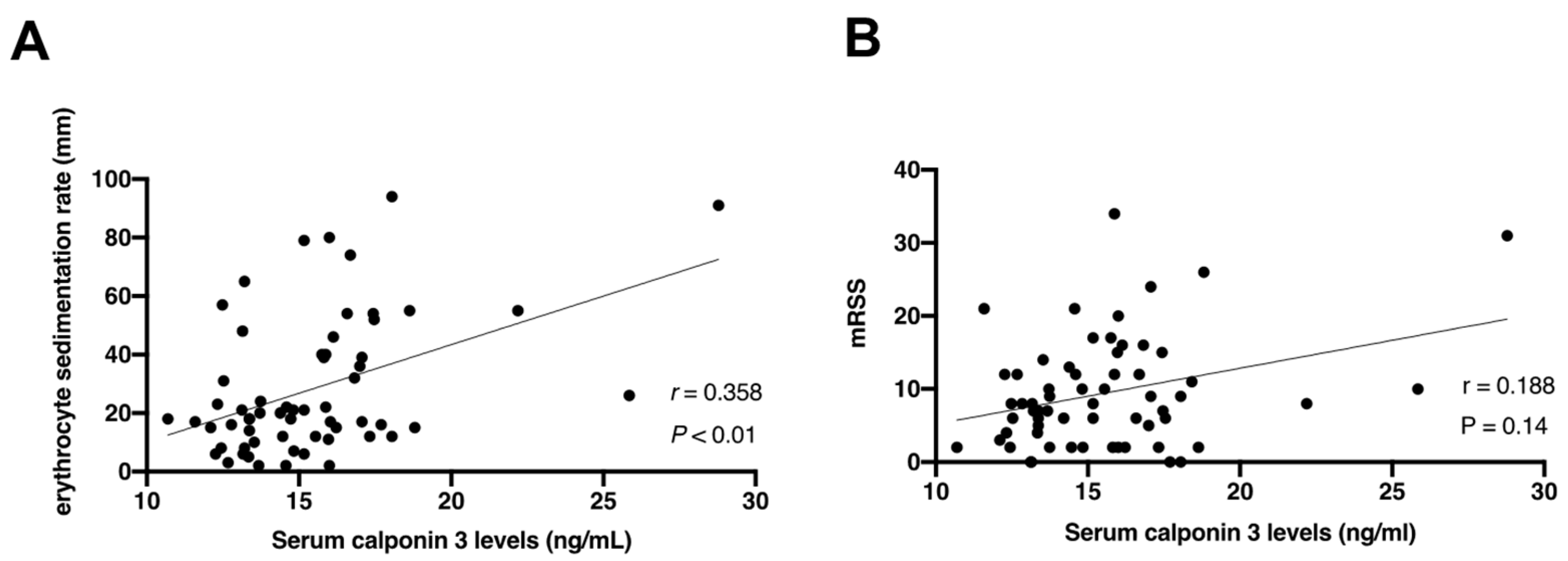Serum Calponin 3 Levels in Patients with Systemic Sclerosis: Possible Association with Skin Sclerosis and Arthralgia
Abstract
1. Introduction
2. Experimental Section
2.1. Serum Samples from Systemic Sclerosis (SSc) Patients and Healthy Controls
2.2. Measurement of Serum Calponin 3 Levels
2.3. Clinical Assessments of Patients
2.4. Statistical Analysis
3. Results
3.1. Serum Calponin 3 Levels Were Elevated in SSc
3.2. Clinical Features of SSc Patients with Elevated Serum Calponin 3 Levels
4. Discussion
Supplementary Materials
Author Contributions
Funding
Institutional Review Board Statement
Informed Consent Statement
Data Availability Statement
Acknowledgments
Conflicts of Interest
References
- LeRoy, E.C.; Black, C.; Fleischmajer, R.; Jablonska, S.; Krieg, T.; Medsger, T.A., Jr.; Rowell, N.; Wollheim, F. Scleroderma (systemic sclerosis): Classification, subsets and pathogenesis. J. Rheumatol. 1988, 15, 202–205. [Google Scholar]
- Yoshizaki, A.; Taniguchi, T.; Saigusa, R.; Fukasawa, T.; Ebata, S.; Numajiri, H.; Nakamura, K.; Yamashita, T.; Takahashi, T.; Toyama, T.; et al. Nucleosome in patients with systemic sclerosis: Possible association with immunological abnormalities via abnormal activation of T and B cells. Ann. Rheum. Dis. 2016, 75, 1858–1865. [Google Scholar] [CrossRef]
- Furst, D.E.; Clements, P.J. Hypothesis for the pathogenesis of systemic sclerosis. J. Rheumatol. Suppl. 1997, 48, 53–57. [Google Scholar]
- Gabrielli, A.; Avvedimento, E.V.; Krieg, T. Scleroderma. N. Engl. J. Med. 2009, 360, 1989–2003. [Google Scholar] [CrossRef] [PubMed]
- Georges, C.; Chassany, O.; Toledano, C.; Mouthon, L.; Tiev, K.; Meyer, O.; Ilie, D.; Rambeloarisoa, J.; Marjanovic, Z.; Cabane, J.; et al. Impact of pain in health related quality of life of patients with systemic sclerosis. Rheumatology (Oxford) 2006, 45, 1298–1302. [Google Scholar] [CrossRef] [PubMed][Green Version]
- Takahashi, K.; Nadal-Ginard, B. Molecular cloning and sequence analysis of smooth muscle calponin. J. Biol. Chem. 1991, 266, 13284–13288. [Google Scholar] [CrossRef]
- Takahashi, K.; Hiwada, K.; Kokubu, T. Vascular smooth muscle calponin. A novel troponin T-like protein. Hypertension 1988, 11, 620–626. [Google Scholar] [CrossRef] [PubMed]
- Liu, R.; Jin, J.P. Calponin isoforms CNN1, CNN2 and CNN3: Regulators for actin cytoskeleton functions in smooth muscle and non-muscle cells. Gene 2016, 585, 143–153. [Google Scholar] [CrossRef]
- Sugenoya, Y.; Yoshimura, A.; Yamamura, H.; Inui, K.; Morita, H.; Yamabe, H.; Ueki, N.; Ideura, T.; Takahashi, K. Smooth-muscle calponin in mesangial cells: Regulation of expression and a role in suppressing glomerulonephritis. J. Am. Soc. Nephrol. 2002, 13, 322–331. [Google Scholar]
- Morioka, T.; Koyama, H.; Yamamura, H.; Tanaka, S.; Fukumoto, S.; Emoto, M.; Mizuguchi, H.; Hayakawa, T.; Kojima, I.; Takahashi, K.; et al. Role of H1-calponin in pancreatic AR42J cell differentiation into insulin-producing cells. Diabetes 2003, 52, 760–766. [Google Scholar] [CrossRef][Green Version]
- Zhao, H.; Yang, K.; Liu, Q.; Hu, J.; Wu, W.; Wang, J. Expression of calponin-1 and its pathogenic role in systemic sclerosis. Nan Fang Yi Ke Da Xue Xue Bao 2019, 39, 279–285. [Google Scholar] [CrossRef] [PubMed]
- Ferhat, L.; Esclapez, M.; Represa, A.; Fattoum, A.; Shirao, T.; Ben-Ari, Y. Increased levels of acidic calponin during dendritic spine plasticity after pilocarpine-induced seizures. Hippocampus 2003, 13, 845–858. [Google Scholar] [CrossRef] [PubMed]
- Shibukawa, Y.; Yamazaki, N.; Kumasawa, K.; Daimon, E.; Tajiri, M.; Okada, Y.; Ikawa, M.; Wada, Y. Calponin 3 regulates actin cytoskeleton rearrangement in trophoblastic cell fusion. Mol. Biol. Cell 2010, 21, 3973–3984. [Google Scholar] [CrossRef]
- Shibukawa, Y.; Yamazaki, N.; Daimon, E.; Wada, Y. Rock-dependent calponin 3 phosphorylation regulates myoblast fusion. Exp. Cell Res. 2013, 319, 633–648. [Google Scholar] [CrossRef] [PubMed]
- Flemming, A.; Huang, Q.Q.; Jin, J.P.; Jumaa, H.; Herzog, S. A Conditional Knockout Mouse Model Reveals That Calponin-3 Is Dispensable for Early B Cell Development. PLoS ONE 2015, 10, e0128385. [Google Scholar] [CrossRef] [PubMed][Green Version]
- Daimon, E.; Shibukawa, Y.; Wada, Y. Calponin 3 regulates stress fiber formation in dermal fibroblasts during wound healing. Arch. Dermatol. Res. 2013, 305, 571–584. [Google Scholar] [CrossRef] [PubMed]
- van den Hoogen, F.; Khanna, D.; Fransen, J.; Johnson, S.R.; Baron, M.; Tyndall, A.; Matucci-Cerinic, M.; Naden, R.P.; Medsger, T.A., Jr.; Carreira, P.E.; et al. 2013 classification criteria for systemic sclerosis: An American College of Rheumatology/European League against Rheumatism collaborative initiative. Arthritis Rheum. 2013, 65, 2737–2747. [Google Scholar] [CrossRef]
- Ciuba, K.; Hawkes, W.; Tojkander, S.; Kogan, K.; Engel, U.; Iskratsch, T.; Lappalainen, P. Calponin-3 is critical for coordinated contractility of actin stress fibers. Sci. Rep. 2018, 8, 17670. [Google Scholar] [CrossRef]
- Leask, A. Scar wars: Is TGFbeta the phantom menace in scleroderma? Arthritis Res. Ther. 2006, 8, 213. [Google Scholar] [CrossRef]
- Pannu, J.; Gore-Hyer, E.; Yamanaka, M.; Smith, E.A.; Rubinchik, S.; Dong, J.Y.; Jablonska, S.; Blaszczyk, M.; Trojanowska, M. An increased transforming growth factor beta receptor type I: Type II ratio contributes to elevated collagen protein synthesis that is resistant to inhibition via a kinase-deficient transforming growth factor beta receptor type II in scleroderma. Arthritis Rheum. 2004, 50, 1566–1577. [Google Scholar] [CrossRef]
- Appel, S.; Allen, P.G.; Vetterkind, S.; Jin, J.P.; Morgan, K.G. h3/Acidic calponin: An actin-binding protein that controls extracellular signal-regulated kinase 1/2 activity in nonmuscle cells. Mol. Biol. Cell 2010, 21, 1409–1422. [Google Scholar] [CrossRef] [PubMed]
- Tuffanelli, D.L.; Winkelmann, R.K. Systemic scleroderma, A clinical study of 727 cases. Arch. Dermatol. 1961, 84, 359–371. [Google Scholar] [CrossRef] [PubMed]
- Randone, S.B.; Guiducci, S.; Cerinic, M.M. Musculoskeletal involvement in systemic sclerosis. Best Pract. Res. Clin. Rheumatol. 2008, 22, 339–350. [Google Scholar] [CrossRef] [PubMed]
- La Montagna, G.; Sodano, A.; Capurro, V.; Malesci, D.; Valentini, G. The arthropathy of systemic sclerosis: A 12 month prospective clinical and imaging study. Skelet. Radiol. 2005, 34, 35–41. [Google Scholar] [CrossRef] [PubMed]
- Baron, M.; Lee, P.; Keystone, E.C. The articular manifestations of progressive systemic sclerosis (scleroderma). Ann. Rheum. Dis. 1982, 41, 147–152. [Google Scholar] [CrossRef] [PubMed]
- Boutry, N.; Hachulla, E.; Zanetti-Musielak, C.; Morel, M.; Demondion, X.; Cotten, A. Imaging features of musculoskeletal involvement in systemic sclerosis. Eur. Radiol. 2007, 17, 1172–1180. [Google Scholar] [CrossRef]
- Schumacher, H.R., Jr. Joint involvement in progressive systemic sclerosis (scleroderma): A light and electron microscopic study of synovial membrane and fluid. Am. J. Clin. Pathol. 1973, 60, 593–600. [Google Scholar] [CrossRef]
- Haag, J.; Aigner, T. Identification of calponin 3 as a novel Smad-binding modulator of BMP signaling expressed in cartilage. Exp. Cell Res. 2007, 313, 3386–3394. [Google Scholar] [CrossRef]
- Salazar, V.S.; Gamer, L.W.; Rosen, V. BMP signalling in skeletal development, disease and repair. Nat. Rev. Endocrinol. 2016, 12, 203–221. [Google Scholar] [CrossRef]
- Birnbaum, J.; Hoke, A.; Lalji, A.; Calabresi, P.; Bhargava, P.; Casciola-Rosen, L. Brief Report: Anti-Calponin 3 Autoantibodies: A Newly Identified Specificity in Patients with Sjögren’s Syndrome. Arthritis Rheumatol. 2018, 70, 1610–1616. [Google Scholar] [CrossRef]


| Characteristic | Elevated Calponin 3 (n = 41) | Normal Calponin 3 (n = 27) | p |
|---|---|---|---|
| Sex, male/female | 4/37 | 2/25 | NS |
| Age, median (IQR) years | 60 (49–70) | 58 (47–66) | NS |
| Disease duration, median (IQR) years | 3.0 (1–7) | 3.2 (1.5–10) | NS |
| No. with dcSSc/no. with lcSSc | 25/16 | 13/14 | NS |
| Clinical features | |||
| mRSS, median (IQR) | 10.0 (2.0–16.0) | 6.5 (3.25–8.75) | 0.04 |
| Raynaud’s phenomenon, % | 90 | 93 | NS |
| Nail fold bleeding, % | 80 | 80 | NS |
| Pitting scar/ulcers, % | 35 | 41 | NS |
| Interstitial lung disease, % | 51 | 44 | NS |
| esophageal dysfunction, % | 73 | 81 | NS |
| Pulmonary hypertention, % | 2.4 | 0 | NS |
| Arthralgia, % | 40 | 8.7 | 0.01 |
| Laboratoly findings | |||
| Anti-topoisomerase I, % | 46 | 52 | NS |
| Anti-centromere, % | 37 | 37 | NS |
| Anti-RNA polymerase III, % | 12 | 7 | NS |
| C-reactive protein, median (IQR) mg/dL | 0.08 (0.04–0.30) | 0.04 (0.01–0.04) | NS |
| Erythrocyte sedimentation rate, median (IQR) mm | 22.0 (12.0–52.0) | 17.5 (8.0–23.75) | NS |
Publisher’s Note: MDPI stays neutral with regard to jurisdictional claims in published maps and institutional affiliations. |
© 2021 by the authors. Licensee MDPI, Basel, Switzerland. This article is an open access article distributed under the terms and conditions of the Creative Commons Attribution (CC BY) license (http://creativecommons.org/licenses/by/4.0/).
Share and Cite
Kotani, H.; Yoshizaki, A.; Matsuda, K.M.; Norimatsu, Y.; Kuzumi, A.; Fukayama, M.; Fukasawa, T.; Ebata, S.; Yoshizaki-Ogawa, A.; Asano, Y.; et al. Serum Calponin 3 Levels in Patients with Systemic Sclerosis: Possible Association with Skin Sclerosis and Arthralgia. J. Clin. Med. 2021, 10, 280. https://doi.org/10.3390/jcm10020280
Kotani H, Yoshizaki A, Matsuda KM, Norimatsu Y, Kuzumi A, Fukayama M, Fukasawa T, Ebata S, Yoshizaki-Ogawa A, Asano Y, et al. Serum Calponin 3 Levels in Patients with Systemic Sclerosis: Possible Association with Skin Sclerosis and Arthralgia. Journal of Clinical Medicine. 2021; 10(2):280. https://doi.org/10.3390/jcm10020280
Chicago/Turabian StyleKotani, Hirohito, Ayumi Yoshizaki, Kazuki M. Matsuda, Yuta Norimatsu, Ai Kuzumi, Maiko Fukayama, Takemichi Fukasawa, Satoshi Ebata, Asako Yoshizaki-Ogawa, Yoshihide Asano, and et al. 2021. "Serum Calponin 3 Levels in Patients with Systemic Sclerosis: Possible Association with Skin Sclerosis and Arthralgia" Journal of Clinical Medicine 10, no. 2: 280. https://doi.org/10.3390/jcm10020280
APA StyleKotani, H., Yoshizaki, A., Matsuda, K. M., Norimatsu, Y., Kuzumi, A., Fukayama, M., Fukasawa, T., Ebata, S., Yoshizaki-Ogawa, A., Asano, Y., Oba, K., & Sato, S. (2021). Serum Calponin 3 Levels in Patients with Systemic Sclerosis: Possible Association with Skin Sclerosis and Arthralgia. Journal of Clinical Medicine, 10(2), 280. https://doi.org/10.3390/jcm10020280






